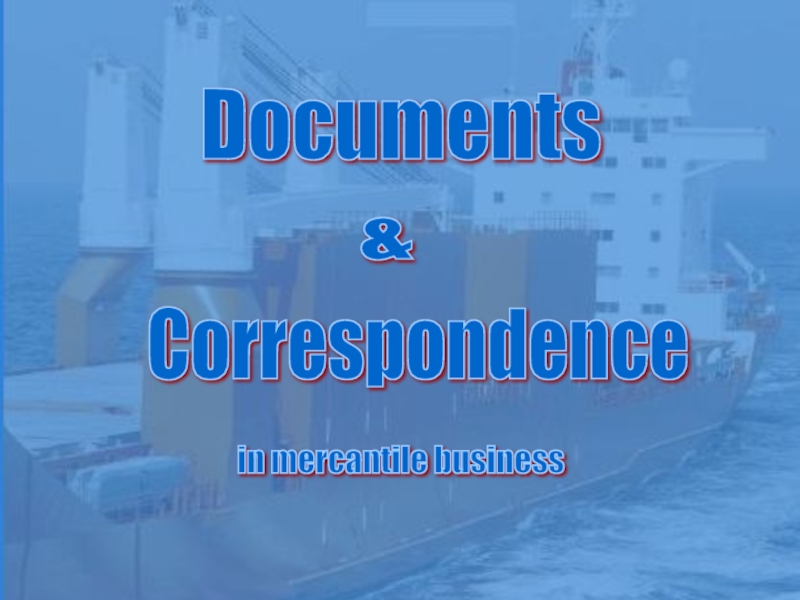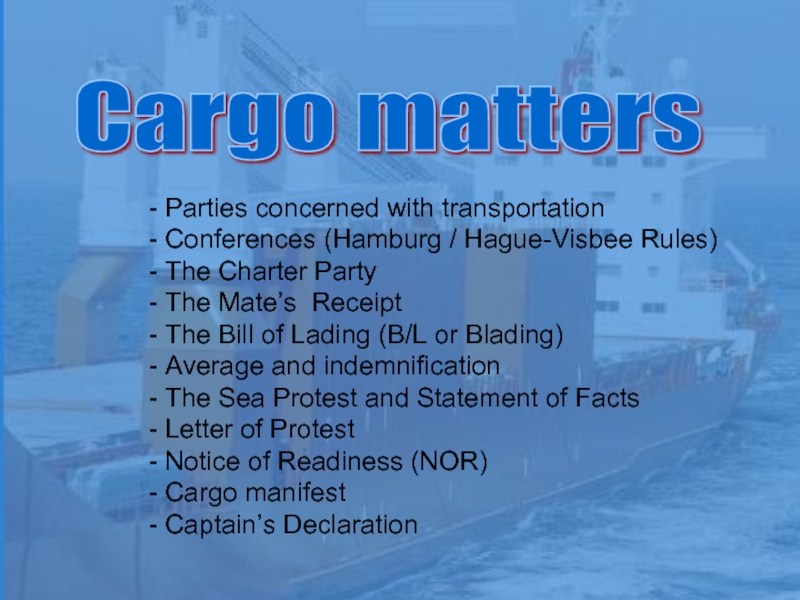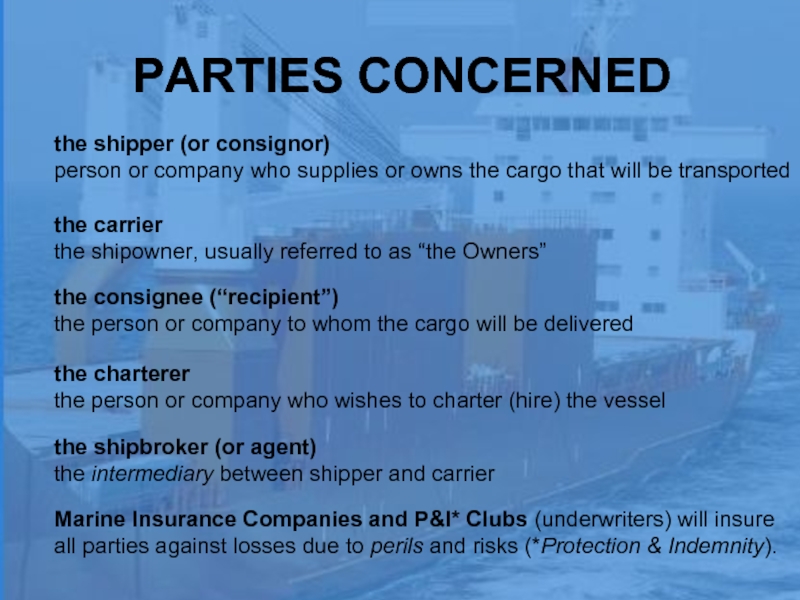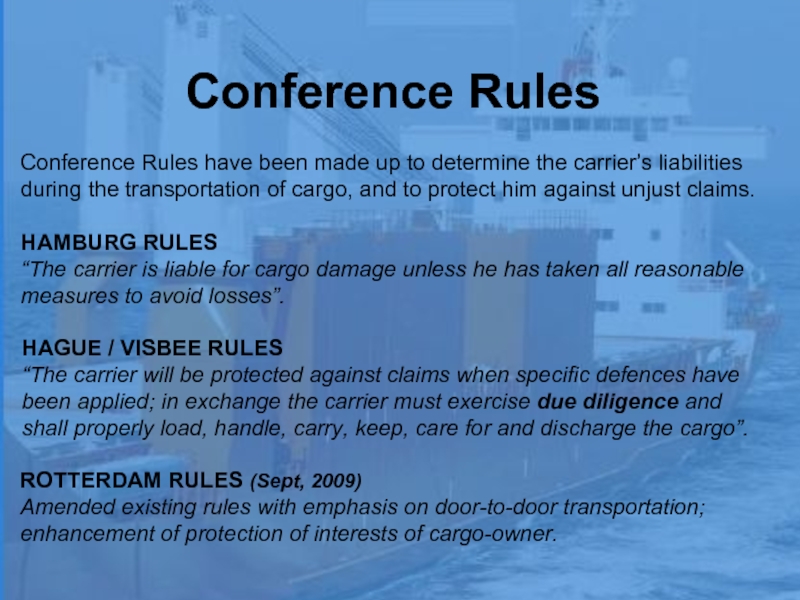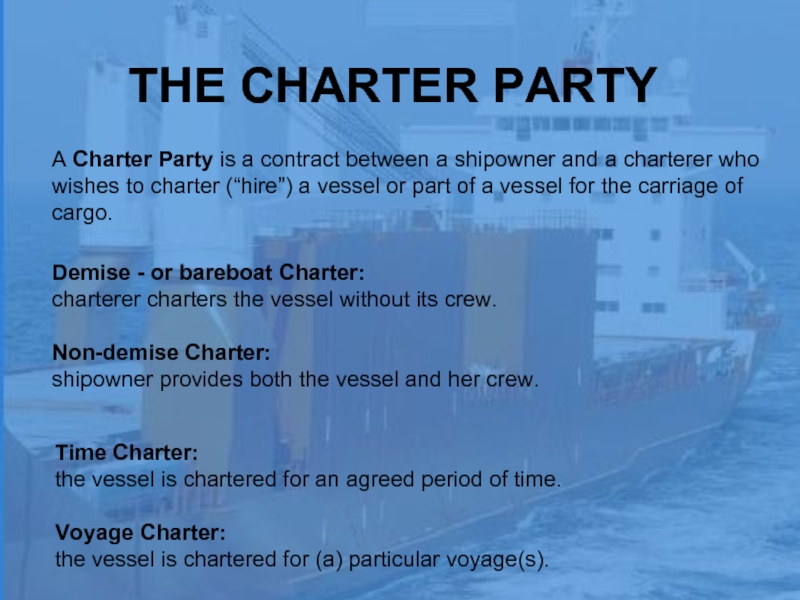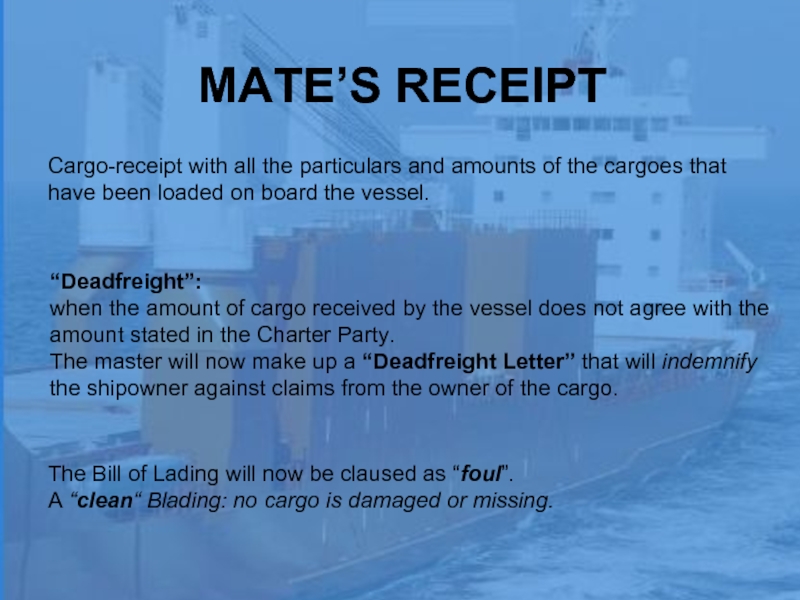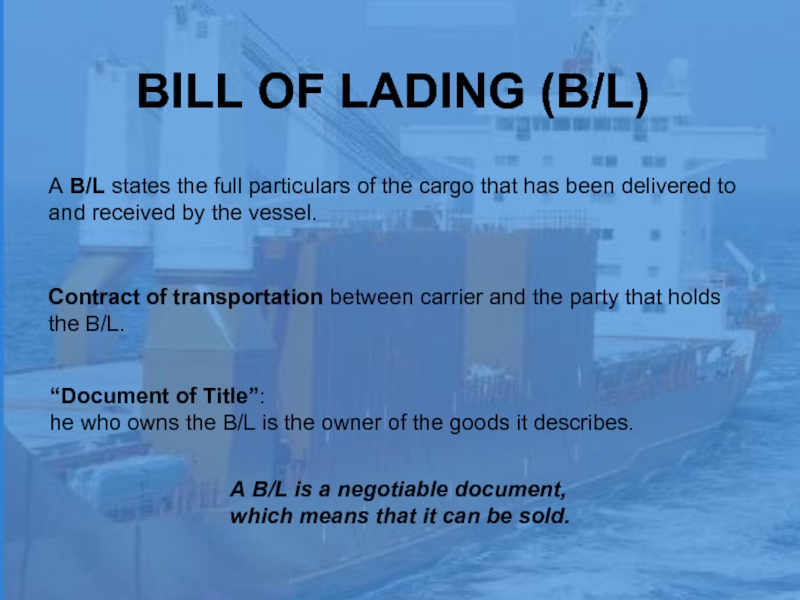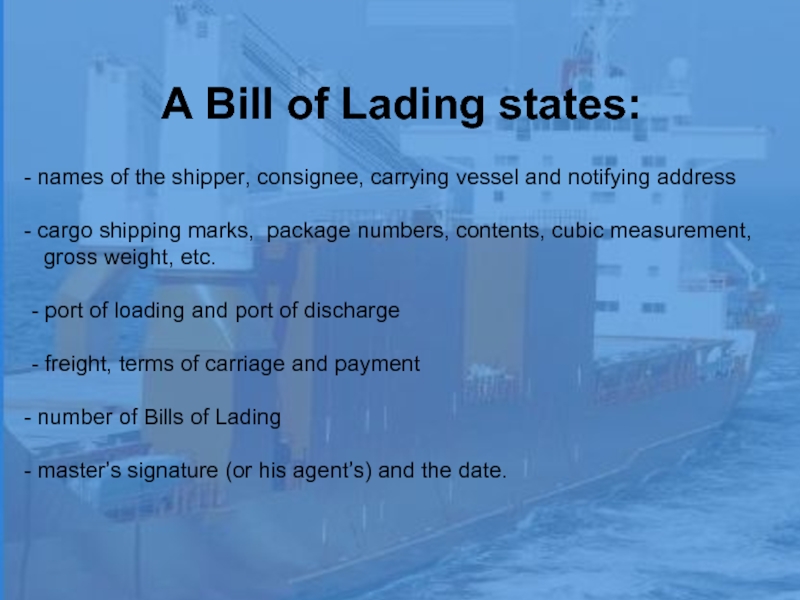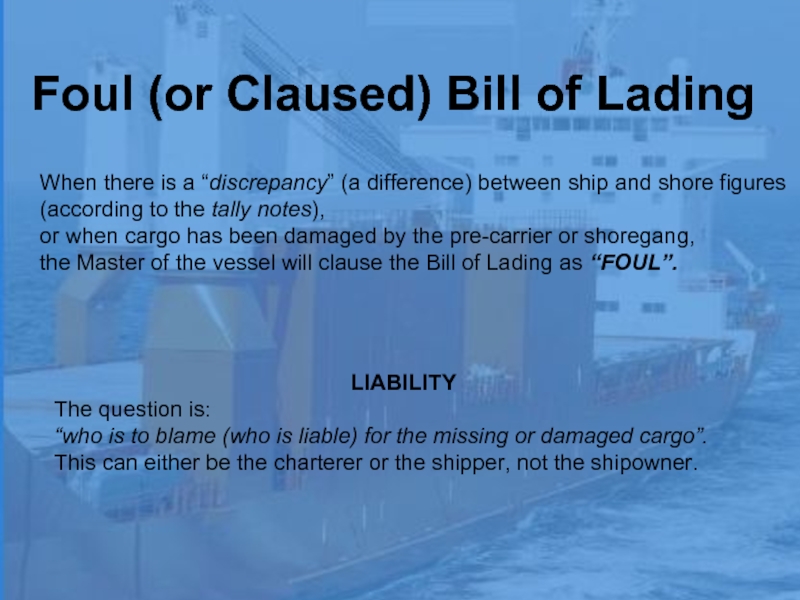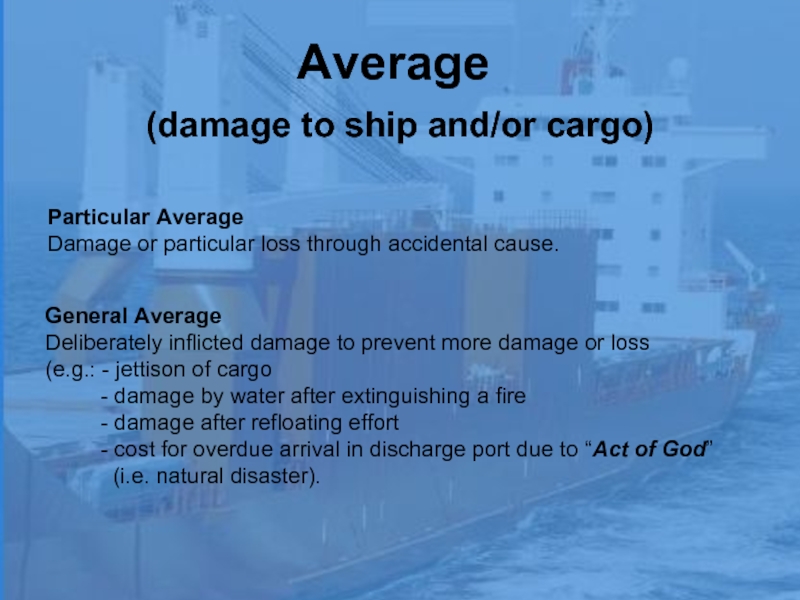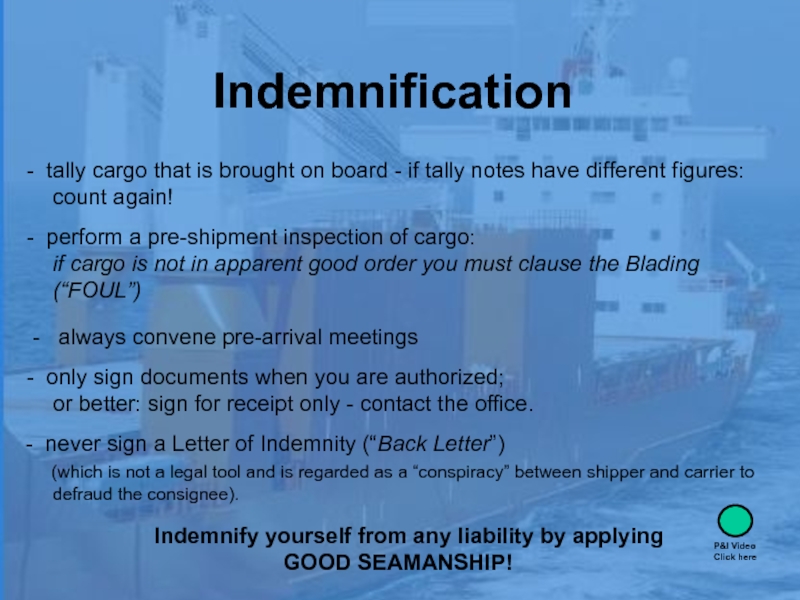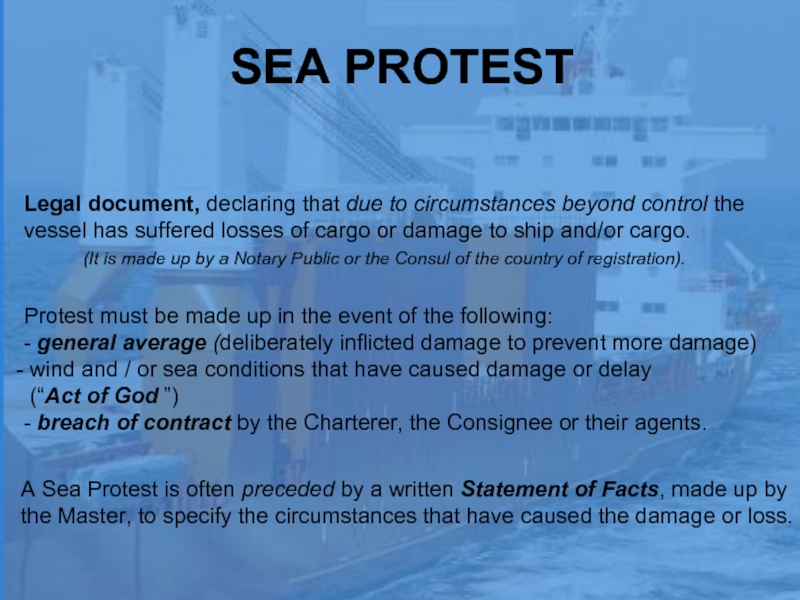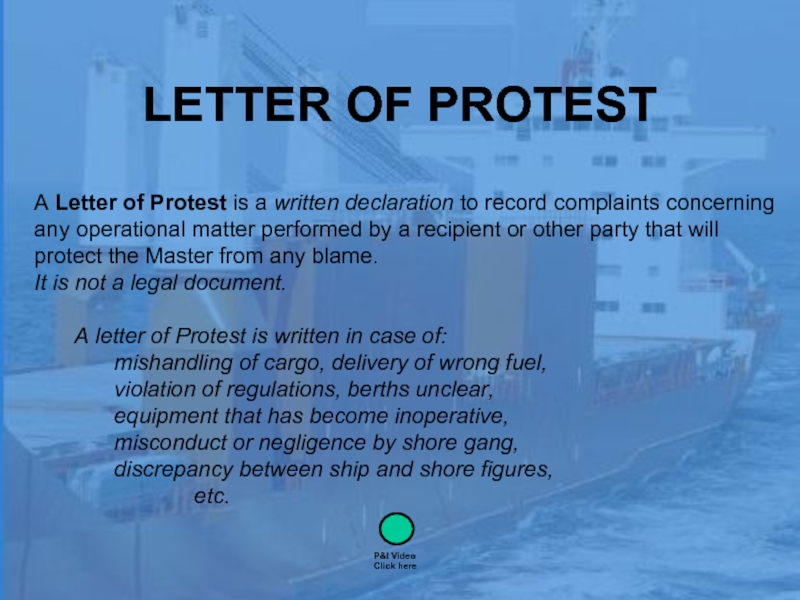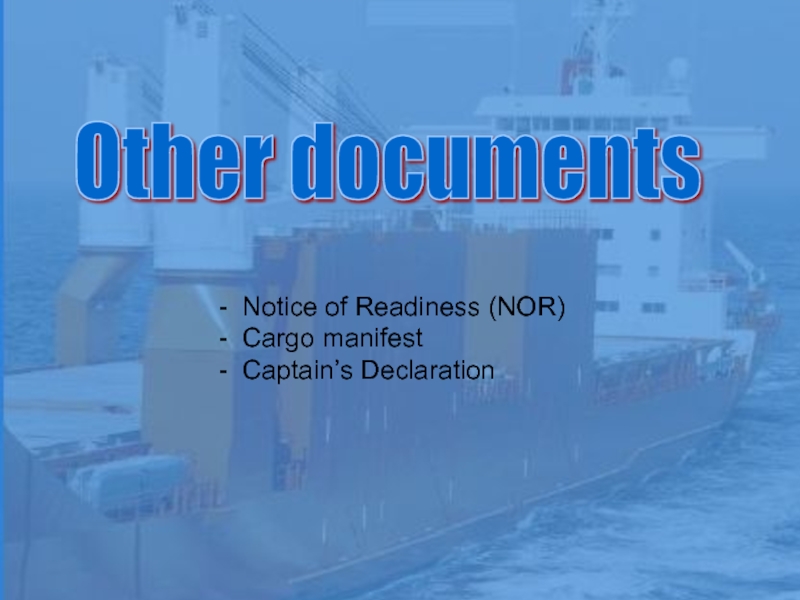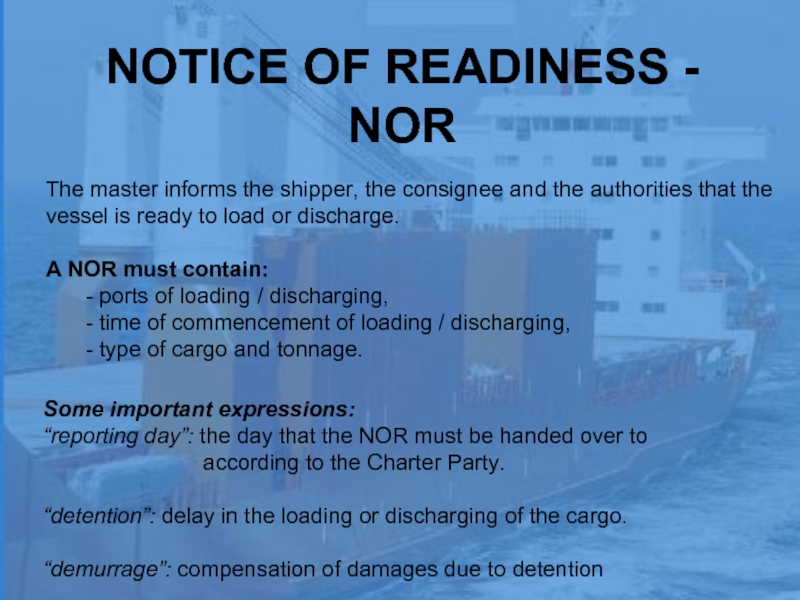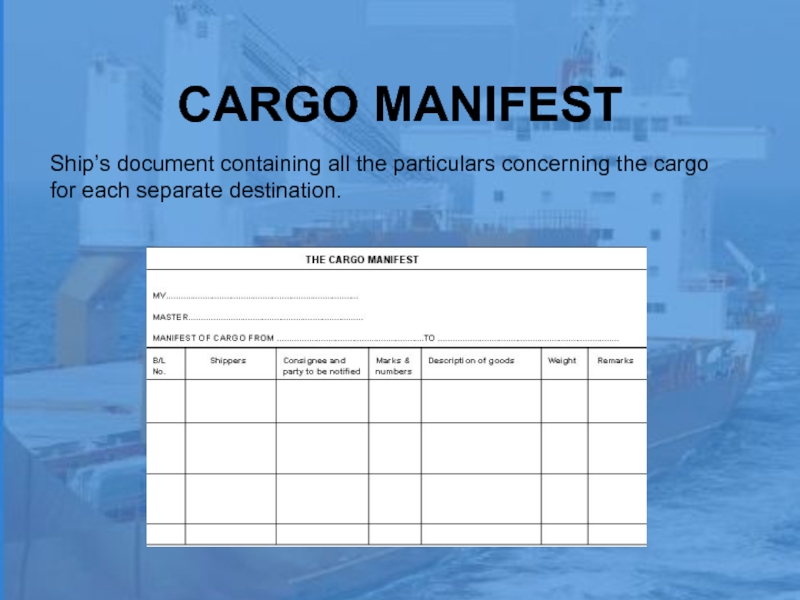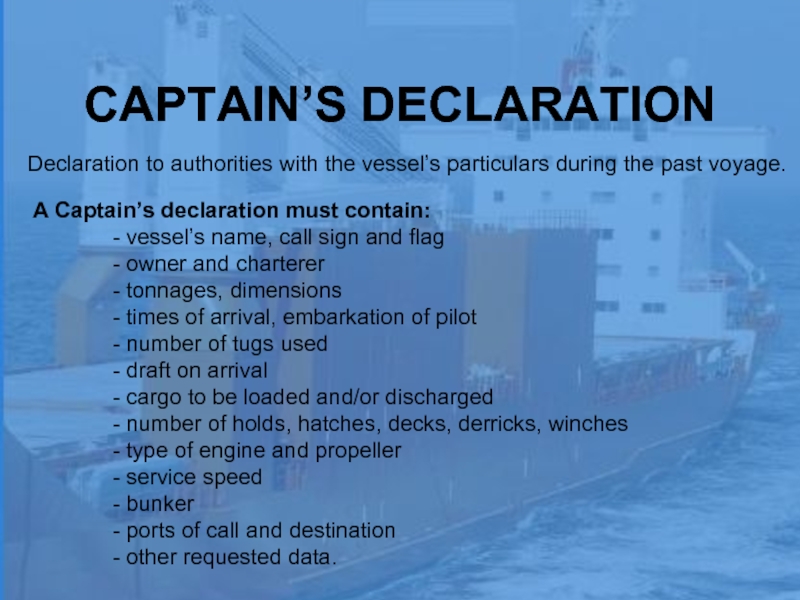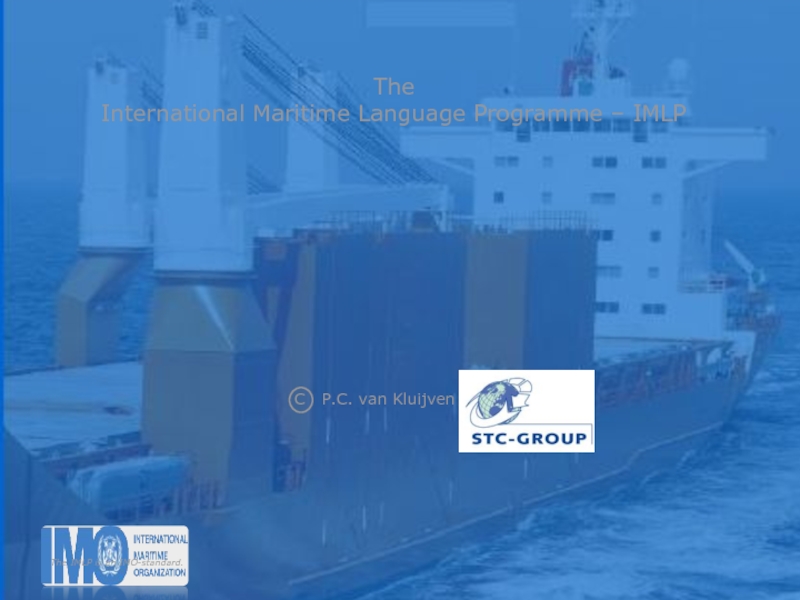- Главная
- Разное
- Дизайн
- Бизнес и предпринимательство
- Аналитика
- Образование
- Развлечения
- Красота и здоровье
- Финансы
- Государство
- Путешествия
- Спорт
- Недвижимость
- Армия
- Графика
- Культурология
- Еда и кулинария
- Лингвистика
- Английский язык
- Астрономия
- Алгебра
- Биология
- География
- Детские презентации
- Информатика
- История
- Литература
- Маркетинг
- Математика
- Медицина
- Менеджмент
- Музыка
- МХК
- Немецкий язык
- ОБЖ
- Обществознание
- Окружающий мир
- Педагогика
- Русский язык
- Технология
- Физика
- Философия
- Химия
- Шаблоны, картинки для презентаций
- Экология
- Экономика
- Юриспруденция
Documents and Correspondence in mercantile business презентация
Содержание
- 1. Documents and Correspondence in mercantile business
- 2. Cargo matters Parties concerned with
- 3. PARTIES CONCERNED the shipper (or consignor) person
- 4. Conference Rules HAMBURG RULES “The carrier is
- 5. THE CHARTER PARTY A Charter Party is
- 6. MATE’S RECEIPT Cargo-receipt with all the particulars
- 7. BILL OF LADING (B/L) A B/L states
- 8. names of the shipper, consignee, carrying
- 9. Foul (or Claused) Bill of Lading When
- 10. Average (damage to ship and/or cargo)
- 11. Indemnification - always convene pre-arrival meetings
- 12. SEA PROTEST Legal document, declaring that
- 13. LETTER OF PROTEST A Letter of Protest
- 14. Other documents Notice of Readiness (NOR) Cargo manifest Captain’s Declaration
- 15. NOTICE OF READINESS - NOR The master
- 16. CARGO MANIFEST Ship’s document containing all the
- 17. CAPTAIN’S DECLARATION A Captain’s declaration must contain:
Слайд 2Cargo matters
Parties concerned with transportation
Conferences (Hamburg / Hague-Visbee
The Charter Party
The Mate’s Receipt
The Bill of Lading (B/L or Blading)
Average and indemnification
The Sea Protest and Statement of Facts
Letter of Protest
Notice of Readiness (NOR)
Cargo manifest
Captain’s Declaration
Слайд 3PARTIES CONCERNED
the shipper (or consignor)
person or company who supplies or owns
the carrier
the shipowner, usually referred to as “the Owners”
the consignee (“recipient”)
the person or company to whom the cargo will be delivered
the charterer
the person or company who wishes to charter (hire) the vessel
the shipbroker (or agent)
the intermediary between shipper and carrier
Marine Insurance Companies and P&I* Clubs (underwriters) will insure
all parties against losses due to perils and risks (*Protection & Indemnity).
Слайд 4Conference Rules
HAMBURG RULES
“The carrier is liable for cargo damage unless he
Conference Rules have been made up to determine the carrier’s liabilities during the transportation of cargo, and to protect him against unjust claims.
HAGUE / VISBEE RULES
“The carrier will be protected against claims when specific defences have been applied; in exchange the carrier must exercise due diligence and shall properly load, handle, carry, keep, care for and discharge the cargo”.
ROTTERDAM RULES (Sept, 2009)
Amended existing rules with emphasis on door-to-door transportation;
enhancement of protection of interests of cargo-owner.
Слайд 5THE CHARTER PARTY
A Charter Party is a contract between a shipowner
Demise - or bareboat Charter:
charterer charters the vessel without its crew.
Non-demise Charter:
shipowner provides both the vessel and her crew.
Time Charter:
the vessel is chartered for an agreed period of time.
Voyage Charter:
the vessel is chartered for (a) particular voyage(s).
Слайд 6MATE’S RECEIPT
Cargo-receipt with all the particulars and amounts of the cargoes
“Deadfreight”:
when the amount of cargo received by the vessel does not agree with the
amount stated in the Charter Party.
The master will now make up a “Deadfreight Letter” that will indemnify
the shipowner against claims from the owner of the cargo.
The Bill of Lading will now be claused as “foul”.
A “clean“ Blading: no cargo is damaged or missing.
Слайд 7BILL OF LADING (B/L)
A B/L states the full particulars of the
Contract of transportation between carrier and the party that holds
the B/L.
“Document of Title”:
he who owns the B/L is the owner of the goods it describes.
A B/L is a negotiable document,
which means that it can be sold.
Слайд 8 names of the shipper, consignee, carrying vessel and notifying address
gross weight, etc.
- port of loading and port of discharge
- freight, terms of carriage and payment
number of Bills of Lading
master’s signature (or his agent’s) and the date.
A Bill of Lading states:
Слайд 9Foul (or Claused) Bill of Lading
When there is a “discrepancy” (a
or when cargo has been damaged by the pre-carrier or shoregang,
the Master of the vessel will clause the Bill of Lading as “FOUL”.
LIABILITY
The question is:
“who is to blame (who is liable) for the missing or damaged cargo”.
This can either be the charterer or the shipper, not the shipowner.
Слайд 10Average
(damage to ship and/or cargo)
Particular Average
Damage or particular loss through
General Average
Deliberately inflicted damage to prevent more damage or loss
(e.g.: - jettison of cargo
- damage by water after extinguishing a fire
- damage after refloating effort
- cost for overdue arrival in discharge port due to “Act of God”
(i.e. natural disaster).
Слайд 11Indemnification
- always convene pre-arrival meetings
perform a pre-shipment inspection
if cargo is not in apparent good order you must clause the Blading
(“FOUL”)
only sign documents when you are authorized;
or better: sign for receipt only - contact the office.
never sign a Letter of Indemnity (“Back Letter”)
(which is not a legal tool and is regarded as a “conspiracy” between shipper and carrier to
defraud the consignee).
tally cargo that is brought on board - if tally notes have different figures:
count again!
Indemnify yourself from any liability by applying
GOOD SEAMANSHIP!
P&I Video
Click here
Слайд 12SEA PROTEST
Legal document, declaring that due to circumstances beyond control the
(It is made up by a Notary Public or the Consul of the country of registration).
Protest must be made up in the event of the following:
- general average (deliberately inflicted damage to prevent more damage)
wind and / or sea conditions that have caused damage or delay
(“Act of God ”)
- breach of contract by the Charterer, the Consignee or their agents.
A Sea Protest is often preceded by a written Statement of Facts, made up by
the Master, to specify the circumstances that have caused the damage or loss.
Слайд 13LETTER OF PROTEST
A Letter of Protest is a written declaration to
It is not a legal document.
A letter of Protest is written in case of:
mishandling of cargo, delivery of wrong fuel,
violation of regulations, berths unclear,
equipment that has become inoperative,
misconduct or negligence by shore gang,
discrepancy between ship and shore figures,
etc.
P&I Video
Click here
Слайд 15NOTICE OF READINESS - NOR
The master informs the shipper, the consignee
vessel is ready to load or discharge.
A NOR must contain:
- ports of loading / discharging,
- time of commencement of loading / discharging,
- type of cargo and tonnage.
Some important expressions:
“reporting day”: the day that the NOR must be handed over to
according to the Charter Party.
“detention”: delay in the loading or discharging of the cargo.
“demurrage”: compensation of damages due to detention
Слайд 16CARGO MANIFEST
Ship’s document containing all the particulars concerning the cargo
for each
Слайд 17CAPTAIN’S DECLARATION
A Captain’s declaration must contain:
- vessel’s name, call sign and
- owner and charterer
- tonnages, dimensions
- times of arrival, embarkation of pilot
- number of tugs used
- draft on arrival
- cargo to be loaded and/or discharged
- number of holds, hatches, decks, derricks, winches
- type of engine and propeller
- service speed
- bunker
- ports of call and destination
- other requested data.
Declaration to authorities with the vessel’s particulars during the past voyage.
